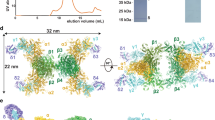Summary
cAMP dependent protein kinase and cAMP independent synthase kinase incorporated up to two Pi/subunit in rabbit skeletal muscle glycogen synthase I. The first Pi/subunit was incorporated much faster than the second. After incorporation of one Pi/subunit by the CAMP dependent protein kinase, the ratio of independence (RI) was 0.20 and the dissociation constant Kc for Glc-6-P was 0.3 mm, and quite different from the RI of 0.02 and Kc (Glc-6-P) of 1 mM, obtained when one Pi/subunit was incorporated by the cAMP independent synthase kinase. Within the first Pi/subunit, the cAMP dependent protein kinase predominantly phosphorylated in the trypsin sensitive region (60–70%), corresponding to two trichloro-acetic acid soluble tryptic phosphopeptides, termed site-1 and site-2. Site-2 was found to be phosphorylated prior to site-1. CNBr degradation resolved the phosphorylated regions in two phosphopeptides with Mr 28,000 and 10,000.
The larger CNBr phosphopeptides were derived from the trypsin sensitive region. Within the first Pi/subunit, synthase kinase almost exclusively phosphorylated in the trypsin insensitive region (80%) corresponding to the smaller CNBr phosphopeptide. However, when two Pi/subunit were incorporated by either the cAMP dependent protein kinase or the synthase kinase the phosphates were almost equally distributed between the trypsin sensitive and insensitive regions and Kc (Glc-6-P) increased to 2 mm, Maximum phosphorylation (2.8–3.3 Pi/subunit and Kc (Glc-6-P) 9–11 mm) was only obtainable when both the cAMP dependent protein kinase and the synthase kinase were present.
The phosvitin kinase very slowly incorporated one Pi/subunit.
We suggest that within the first P1subunit phosphorylation in the trypsin insensitive region determine the affinity for the allosteric activator, glucose-6-phosphate. Thereafter phosphorylation in the trypsin sensitive region is the major determinant. Purified glycogen-free rabbit skeletal muscle glycogen synthase binds glycogen with lower affinity than polymorphonuclear leukocyte glycogen synthase. Glycogen was found to increase the initial rate of phosphorylation and facilitate the phosphorylation of site-1.
Similar content being viewed by others
Abbreviations
- cAMP:
-
adenosine cyclic 3′:5′-monophosphate
- Glc-6-P :
-
glucose-6-phosphate
- UDP-Glc:
-
uridine 5′-diphosphoglucose
- EGTA:
-
ethylene glycol-bis(β-aminoethylether)-N,N′-tetraacetic acid
- EDTA:
-
ethylenediamine tetraacetic acid
- CNBr:
-
cyanogen bromide
- DTT:
-
dithiothreitol
- SDS:
-
sodium dodecyl sulphate
- RI:
-
ratio of independence
References
Roach, P. J., Takeda, Y., and Larner, J., 1976. J. Biol. Chem. 251, 1913–1919.
Soderling, T. R., Hickenbottom, J. P., Reimann, E. M., Hunkeler, F. L., Walsh, D. A., and Krebs, E. G., 1970. J. Biol. Chem. 245, 6317–6328.
Roach, P. J., De-Paoli-Roach, A. A., and Larner, J., 1978. J. Cyclic Nucleotide Res. 4, 245–257.
Soderling, T. R., Srivastava, A. K., Bass, M. A., and Khatra, B. S., 1979. Proc. Natl. Acad. Sci. USA 76, 2536–2540.
Huang, K.-P., Huang, F. L., Glinsman, W. H., and Robinson, J. C., 1975. Biochem. Biophys. Res. Commun. 65, 1163–1169.
Nimmo, H. G., Proud, C. G., and Cohen, P., 1976. Eur. J. Biochem. 68, 31–44.
Soderling, T. R., Jelt, M. F., Hutson, N. J., and Khatra, B. S., 1977 J. Biol. Chem. 252, 7517–7524.
Soderling, T. R., 1976. J. Biol. Chem. 251, 4359–4364.
Proud, C. G., Rylatt, D. B., Yeaman, S. J., and Cohen, P., 1977. FEBS Lett. 80, 435–442.
Itarte, E., Robinson, J. C., and Huang, K-P., 1977. J. Biol. Chem. 252, 1231–1234.
Itarte, E. and Huang, K.-P., 1979. J. Biol. Chem. 254, 4052–4057.
Juhl, H. and Esmann, V., 1979. Mol. Cell. Biochem. 26, 3–18.
Juhl, H., 1979. Mol. Cell. Biochem. 26, 19–27.
Nimmo, H. G., Proud, C. G., and Cohen, P., 1976. Eur. J. Biochem. 68, 21–30.
Thomas, J. A., Schlender, K. K., and Larner, J., 1968. Anal. Biochem. 25, 486–499.
Sølling, H., 1979. Eur. J. Biochem. 94, 231–242.
Weber, K. and Osborn, M., 1969. J. Biol. Chem. 244, 4406–4412.
Plesner, L., Plesner, I. W., and Esmann, V., 1974. J. Biol. Chem. 249, 1119–1125.
Sølling, H. and Esmann, V., 1977. Eur. J. Biochem. 81, 129–139.
Schlender, K. K. and Larner, J., 1973. Biochim. Biophys. Acta, 293, 73–83.
Soderling, T. R., 1975. J. Biol. Chem. 250, 5407–5412.
Solling, H. and Esmann, V., 1977. Eur. J. Biochem. 81, 119–128.
Hutson, N. J., Khatra, B. S., and Soderling, T. R., 1977. J. Biol. Chem. 253, 2540–2545.
Huang, T-S and Krebs, E. G., 1977. Biochem. Biophys. Res. Commun. 75, 643–650.
Saugmann, P., 1977. Biochem. Biophys. Res. Commun. 74, 1511–1519.
Saugmann, P. and Esmann, V., 1977. Biochem. Biophys. Res. Commun. 74, 1520–1527.
Author information
Authors and Affiliations
Rights and permissions
About this article
Cite this article
Juhl, H., Esmann, V. Phosphorylation of rabbit skeletal muscle glycogen synthase 1 by the cAMP dependent protein kinase, the cAMP independent synthase kinase and the phosvitin kinase from human polymorphonuclear leukocytes. Mol Cell Biochem 30, 131–141 (1980). https://doi.org/10.1007/BF00230166
Received:
Issue Date:
DOI: https://doi.org/10.1007/BF00230166




